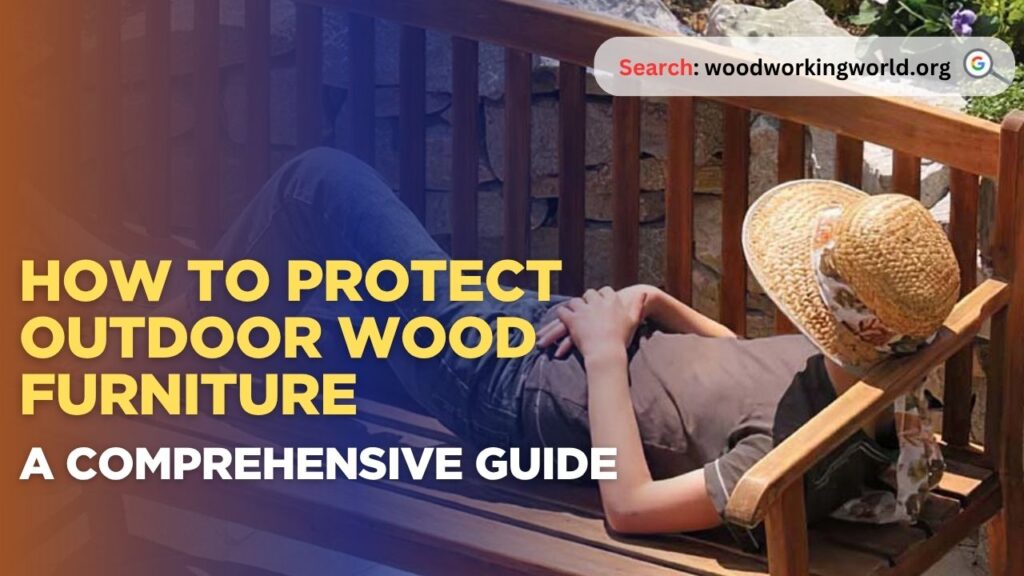Outdoor wood furniture adds charm and comfort to patios, gardens, and decks, but exposure to sun, rain, and temperature changes can quickly take a toll. Without proper care, wood can warp, crack, fade, or rot, turning your investment into a maintenance headache. Protecting your furniture not only preserves its beauty but also extends its lifespan, saving you time and money in the long run.
In “How to Protect Outdoor Wood Furniture: A Comprehensive Guide,” we’ll cover the best treatments, finishes, and maintenance routines to shield your furniture from the elements. From sealing and staining to cleaning and covering techniques, you’ll learn step-by-step methods to keep your outdoor wood looking great season after season, no matter the weather.

👉 CLICK HERE to Unlock 16,000+ DIY woodworking plans now
How to Protect Outdoor Wood Furniture
1. Understanding the Challenges
Outdoor wood furniture faces several environmental challenges:
- Moisture: Rain, dew, and humidity can lead to wood swelling, warping, and rotting.
- Sunlight: UV rays can cause wood to fade, dry out, and crack.
- Temperature Fluctuations: Extreme temperatures can make wood expand and contract, leading to structural damage.
- Pests: Insects like termites and beetles can infest wood, causing significant damage.
- Dirt and Grime: Dust, bird droppings, and other debris can accumulate, making furniture look unkempt and potentially damaging the wood.
Understanding these challenges helps in selecting the right protection methods and materials for your outdoor wood furniture.
👉 CLICK HERE to Unlock 16,000+ DIY woodworking plans now
2. Choosing the Right Wood
Different types of wood have varying levels of durability and resistance to outdoor conditions. When selecting outdoor furniture, consider woods that are naturally resistant to decay and insects, such as:
- Teak: Highly durable and resistant to moisture and insects due to its natural oils.
- Cedar: Contains natural oils that deter insects and resist rot.
- Redwood: Naturally resistant to decay and insects, though it can be more expensive.
- Eucalyptus: Hard, dense, and resistant to moisture and pests.
Investing in high-quality wood can make a significant difference in the longevity and maintenance of your outdoor furniture.
3. Applying Protective Finishes
Applying protective finishes is one of the most effective ways to safeguard outdoor wood furniture. These finishes create a barrier against moisture, UV rays, and dirt. Here are some common options:
- Sealants: Clear sealants penetrate the wood, providing protection without altering its natural appearance. They need to be reapplied every 1-2 years.
- Stains: Stains add color to the wood while also offering protection. They come in various shades and can enhance the natural beauty of the wood.
- Paints: Paints provide a strong protective layer and come in numerous colors. However, they cover the natural grain of the wood.
- Varnishes: Varnishes create a hard, glossy surface that protects against moisture and UV rays. They can crack and peel over time, requiring periodic maintenance.
For best results, choose a finish that suits your aesthetic preferences and provides adequate protection for your climate.
4. Regular Cleaning and Maintenance
Regular cleaning and maintenance are crucial for keeping outdoor wood furniture in top condition. Follow these steps for effective upkeep:
- Cleaning: Use a mild soap and water solution to clean the furniture regularly. Avoid harsh chemicals that can damage the wood. A soft brush can help remove dirt and debris.
- Rinsing: After cleaning, rinse the furniture thoroughly with clean water to remove any soap residue.
- Drying: Allow the furniture to dry completely before applying any protective finishes or storing it.
- Inspecting: Regularly inspect the furniture for signs of damage, such as cracks, splinters, or insect infestations. Address any issues promptly to prevent further deterioration.
5. Seasonal Protection
Different seasons pose different threats to outdoor wood furniture. Implement these strategies to protect your furniture year-round:
- Spring and Summer: During warmer months, UV rays and humidity are the primary concerns. Apply a UV-protective finish and clean the furniture regularly to prevent dirt buildup and mold growth.
- Fall: As temperatures drop, moisture becomes a more significant issue. Ensure the furniture is thoroughly cleaned and sealed before the rainy season.
- Winter: If possible, store outdoor furniture indoors or cover it with weatherproof covers. Make sure the covers are breathable to prevent mold and mildew.


6. Using Furniture Covers
Furniture covers are an excellent way to protect outdoor wood furniture from the elements. Choose covers that are:
- Waterproof: To keep moisture out and prevent rot and mold.
- UV-Resistant: To protect against fading and sun damage.
- Breathable: To prevent condensation and mold growth underneath the cover.
- Durable: Made from high-quality materials that can withstand harsh weather conditions.
Ensure the covers fit properly and secure them tightly to prevent them from being blown away by the wind.
7. Preventing Insect Damage
Insects can cause significant damage to outdoor wood furniture. To prevent infestations:
- Choose Insect-Resistant Wood: As mentioned earlier, woods like teak, cedar, and redwood are naturally resistant to insects.
- Apply Insecticides: Use insecticides designed for wood to deter pests. Be sure to follow the manufacturer’s instructions for safe application.
- Inspect Regularly: Check for signs of insect activity, such as holes, sawdust, or live insects. Treat any infestations promptly to prevent further damage.
8. Avoiding Direct Ground Contact
Prolonged contact with the ground can expose wood to moisture and pests. To prevent this:
- Use Elevation: Place furniture on pavers, stones, or rubber feet to elevate it off the ground.
- Move Periodically: If possible, move the furniture occasionally to allow the ground underneath to dry out and prevent pest buildup.
9. Choosing the Right Location
Where you place your outdoor wood furniture can significantly impact its longevity. Consider these factors when choosing a location:
- Shade: Position furniture in shaded areas to reduce exposure to direct sunlight. This helps prevent fading and drying.
- Protection: Place furniture in sheltered spots, such as under eaves, pergolas, or awnings, to shield it from rain and wind.
- Drainage: Ensure the location has good drainage to prevent water from pooling around the furniture.
10. Refinishing and Restoring
Even with the best care, outdoor wood furniture may eventually show signs of wear and tear. Refinishing and restoring can bring it back to life. Here’s how:
- Sanding: Sand the surface to remove old finishes, stains, and imperfections. Start with coarse-grit sandpaper and progress to finer grits for a smooth finish.
- Cleaning: Clean the sanded furniture to remove dust and debris.
- Applying New Finish: Apply a fresh coat of sealant, stain, or paint, following the manufacturer’s instructions. Allow each coat to dry thoroughly before applying the next.
- Polishing: For a glossy finish, consider applying a coat of varnish or polish after the final finish has dried.
11. Storing Furniture During Off-Seasons
If you live in an area with harsh winters or extreme weather conditions, storing outdoor wood furniture during the off-season is advisable. Follow these tips for proper storage:
- Clean and Dry: Ensure the furniture is clean and completely dry before storing it.
- Disassemble: If possible, disassemble the furniture to save space and reduce the risk of damage.
- Cover: Use breathable covers to protect the furniture from dust and moisture.
- Store Indoors: Store the furniture in a dry, sheltered area, such as a garage, shed, or basement.
12. Investing in Quality
Lastly, investing in high-quality outdoor wood furniture from reputable manufacturers can make a significant difference. Quality furniture is built to withstand the elements and often comes with better warranties and support. While it may cost more upfront, the long-term savings in maintenance and replacement costs can be substantial.
👉 CLICK HERE to Unlock 16,000+ DIY woodworking plans now
Conclusion: How to Protect Outdoor Wood Furniture
How to Protect Outdoor Wood Furniture: Protecting outdoor wood furniture requires a combination of selecting the right wood, applying protective finishes, regular maintenance, and strategic placement and storage. By following these guidelines, you can ensure your outdoor wood furniture remains beautiful, functional, and durable for many years to come. Taking the time to care for your furniture not only preserves its aesthetic appeal but also extends its lifespan, allowing you to enjoy your outdoor living space to the fullest.
I hope this article on How to Protect Outdoor Wood Furniture has been helpful. If you have any further questions, please feel free to leave a comment below.
👉 CLICK HERE to Unlock 16,000+ DIY woodworking plans now
